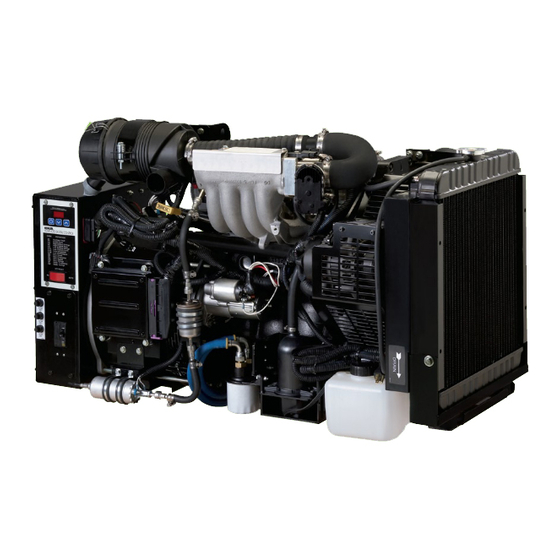Kohler 15ERG Betriebshandbuch - Seite 27
Blättern Sie online oder laden Sie pdf Betriebshandbuch für Tragbarer Generator Kohler 15ERG herunter. Kohler 15ERG 48 Seiten. Commercial mobile generator set

3.7 Exhaust System
WARNING
Carbon monoxide.
Can
cause
fainting, or death.
The
exhaust
leakproof and routinely inspected.
Inspecting the exhaust system. Carbon monoxide can
cause severe nausea, fainting, or death. For the safety of
the craft's occupants, install a carbon monoxide detector.
Consult the boat builder or dealer for approved detector
location and installation. Inspect the detector before each
generator set use. In addition to routine exhaust system
inspection, test the carbon monoxide detector per the
manufacturer's instructions and keep the detector operational
at all times.
At the interval specified in the service schedule, inspect
the exhaust system components (exhaust manifold,
exhaust outlet, exhaust line, exhaust clamps, and
muffler) for cracks, leaks, and corrosion.
Exhaust System Inspection Points
D
Check for corroded or broken metal parts and replace
them as needed.
D
Check for loose, corroded, or missing clamps and
hangers. Tighten or replace the exhaust clamps
and/or hangers as needed.
D
Check that the exhaust outlet is unobstructed.
D
Check the exhaust gas color. If the exhaust is blue or
black, contact your local distributor/dealer.
D
Visually inspect for exhaust leaks (blowby). Check
for carbon or soot residue on exhaust components.
Carbon and soot residue indicates an exhaust leak.
Seal leaks as needed.
D
Ensure that the carbon monoxide detector is (1) in the
vehicle, (2) functional, and (3) energized whenever
the generator set operates.
TP-6334
9/04
severe
nausea,
system
must
be
3.8 Cooling System
WARNING
Hot coolant and steam.
Can cause severe injury or death.
Before removing the pressure cap,
stop the generator set and allow it to
cool. Then loosen the pressure cap
to relieve pressure.
Checking the coolant level. Hot coolant can cause severe
injury or death. Allow the engine to cool. Release pressure
from the cooling system before removing the pressure cap. To
release pressure, cover the pressure cap with a thick cloth and
then slowly turn the cap counterclockwise to the first stop.
Remove the cap after pressure has been completely released
and the engine has cooled. Check the coolant level at the tank
if the generator set has a coolant recovery tank.
3.8.1
Checking the Cooling System
See Figure 3-6 for coolant capacity See Figure 3-7 for
thermostat and pressure cap ratings.
To prevent generator shutdown or damage because of
overheating, keep the cooling air inlets clean and
unobstructed at all times. Inspect the radiator's exterior
for obstructions and remove dirt and foreign material
with a soft brush or cloth to avoid damaging the radiator
fins. Check the hoses and connections for leaks and
replace any cracked, frayed, or spongy hoses. When
checking the coolant level, also check the rubber seal of
the radiator's pressure cap and replace a cracked or
deteriorated cap. The pressure cap raises the boiling
point of the coolant, enabling higher operating
temperatures. If the cap leaks, replace it with the same
rating type of cap. Find the pressure cap rating in
Figure 3-7. Remove dirt and other debris from the
pressure cap and filler neck. See Figure 3-6 for the
coolant capacity.
Model
All models
Figure 3-6 Coolant Capacity
Model
Pressure Cap Rating
Thermostat Rating
Figure 3-7 Pressure Cap and Thermostat Rating
L (Qts.)
7.6 (8.0)
10/13/15EG
96.5 kPa (14 psi)
91_C (195_F)
Scheduled Maintenance 15
